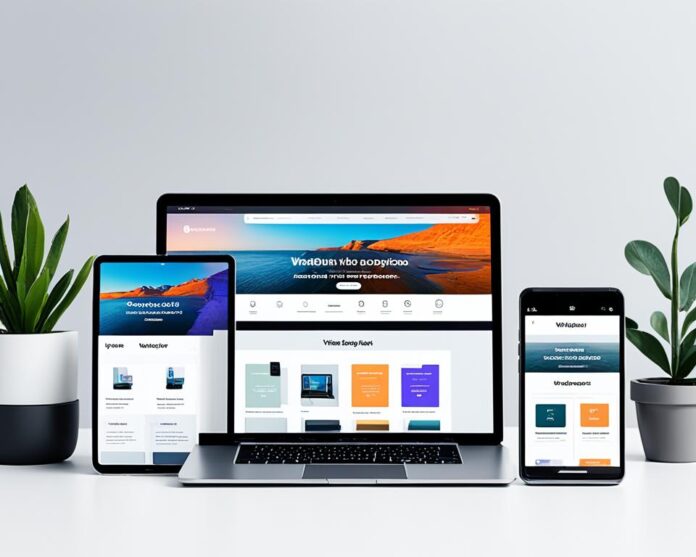Are you tired of the technical hurdles that come with building websites? Do you want to design and launch dynamic websites without writing a single line of code? Webflow is your solution. This no-code platform lets you design websites easily. You can create stunning websites without the limits of traditional tools.
Imagine customizing your web pages by dragging and dropping elements. You can say goodbye to limits and have full control over your site’s look. Now, you don’t have to give up on your design dreams.
Webflow offers more than just design tools. It has a powerful CMS (Content Management System) for your website’s content. You won’t need to update pages by hand anymore. With Webflow, adding, editing, and managing content becomes easy.
So, are you ready to let your creativity fly and take control of your web projects? Join us to discover all that Webflow offers. Learn how to design and launch websites visually, without coding. Let’s change the way websites are built!
Webflow Ecommerce and Accessibility
Webflow lets you build and design ecommerce stores easily. No coding is needed. With Webflow Ecommerce, you can make every part of your online store just right. This tool is great for creating eye-catching websites without a hassle.
But Webflow is more than just for online stores. It makes sure websites are easy for everyone to use. Accessibility is key for Webflow. This means they help you make websites everyone can enjoy, no matter what.
Webflow gives users tips and tricks on making websites welcoming for all. They have tutorials, articles, and webinars. These resources teach how to include everyone. Webflow wants all users to easily get to and use the websites made with their tool.
“Webflow’s commitment to inclusive design and accessibility sets them apart from other website builders in the market. Their no-code platform empowers users to create online stores that are not only visually appealing, but also accessible to all users, including those with disabilities.” – Sarah Thompson, Web Designer
With Webflow, making ecommerce stores and accessible sites is simple. This combination makes it a top choice. If you want to create websites that succeed online, Webflow is the way to go.
Webflow Learning Resources and Courses
Webflow has a variety of learning resources and courses. They are designed to help users improve their web design skills. Whether starting out or seeking to advance, Webflow offers valuable tools for everyone.
Webflow 101: Mastering Web Design Fundamentals
For those new to web design, Webflow 101 is an ideal beginning. It teaches the basics of web design and development. You’ll learn everything from responsive design principles to using the visual editor.
Webflow 101 provides a comprehensive overview of web design fundamentals, empowering users to build visually compelling websites with ease.
Web Animations: Bringing Your Designs to Life
Want to enhance your designs with animations? Webflow’s animation courses teach you how to make your websites interactive. Learn to use Adobe After Effects and Lottie for motion and effects.
Web animations courses open up a world of possibilities, allowing designers to turn static designs into dynamic and memorable experiences.
Design Portfolio Course: Showcasing Your Skills
Creating a strong design portfolio can showcase your skills and draw clients. Webflow’s course helps you make an impressive portfolio in 21 days. You’ll learn to craft a story and select your best work.
A well-crafted design portfolio is the key to unlocking new opportunities and advancing your career as a freelance web designer.
Freelance Web Design: Mastering the Business Side
Webflow understands web design also involves business savvy. Their freelance course teaches finding clients and pricing services. It’s full of insights for a successful freelance career.
Mastering the business side of freelance web design is crucial for building a successful and sustainable career.
CSS Grid: Harnessing the Power of Layouts
CSS Grid lets you design flexible, dynamic websites. Webflow’s course covers everything about CSS Grid. Learn to make complex layouts that work on any screen size.
CSS Grid is a game-changer in web design, enabling designers to create intricate and adaptive layouts with ease.
Figma to Webflow: Seamless Design Integration
If Figma is part of your design process, Webflow’s course is for you. It teaches moving designs from Figma to Webflow. This saves time and makes the design to development process smoother.
The Figma to Webflow course bridges the gap between design and development, facilitating a seamless workflow and saving valuable time.
SEO Fundamentals: Optimizing for Discoverability
Learning SEO can make your website more visible. Webflow’s SEO course covers content optimization to rank higher in search results. It includes keyword research, on-page, and technical SEO tips.
SEO fundamentals provide the foundation for enhancing your website’s visibility and driving targeted organic traffic.
Webflow’s courses and resources help designers grow their skills and stay current with trends. This comprehensive platform takes your web design abilities further, leveraging Webflow to its fullest.
Steps to Designing a Website with Webflow
Designing a website with Webflow has key steps. If you follow them, you can make a site that’s both nice to look at and works well. It will fit exactly what you need and want.
Step 1: Define Website Goals
First, you need to figure out your website’s goals. Think about its purpose, what it should do, and who will use it. With clear goals, your website can really hit its mark. It will do what you want for your business or personal use.
Step 2: Research and Plan Content
Next, look into your content. Check out what others are doing, get inspired, and sketch your ideas. This step makes sure your site will catch people’s attention. It will also give them what they need.
Step 3: Design Brand Identity
Now, shape your website’s brand identity. Choose your colors, fonts, and images. Also, think about how your website should sound to visitors. A strong brand identity makes you stand out online. It shows off your unique style or brand well.
Step 4: Create Wireframes
Wireframes show how your site will be set up. They help you see your site’s structure early on. With wireframes, you can tweak your design until it’s perfect. This means a better experience for your users.
Step 5: Draft Site Copy
With wireframes ready, it’s time to write your site’s text. Think about how you want to sound. Your words should match your brand and draw in readers.
By doing these steps, your Webflow site will not just look good. It’ll also do exactly what you want. And, it will draw in and keep your visitors’ attention.
Conclusion
Webflow is more than just a tool to build websites. It’s a full solution for making custom websites easily. It has everything you need to make professional sites without coding. This includes e-commerce, SEO tools, and great hosting.
The visual editor in Webflow is a game-changer. It’s easy to use and lets you animate designs. You can make your website stand out with animations and smooth transitions, no coding needed.
Webflow also excels in connecting with other tools through API integration. Teams can collaborate well, making design and development smoother. This makes your workflow a lot easier.
Customizing templates is a big plus with Webflow. It lets you adjust everything to fit your brand. You can change fonts, colors, and how your site is laid out. This ensures your website is just how you want it.
In conclusion, Webflow gives you all the necessary tools for web development. It’s great for anyone, from beginners to seasoned developers. With Webflow, creating visually impressive websites is simple and fun.
Source Links
- https://webflow.com/blog/how-to-design-a-website
- https://webflow.com/
- https://university.webflow.com/courses/cms-and-dynamic-content



